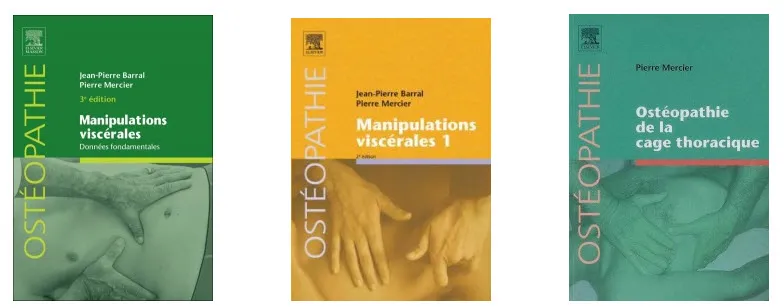Introduction
Pierre Mercier, born in 1949, is a renowned Canadian osteopath specializing in the field of visceral osteopathy. His exceptional career has been marked by the development of innovative techniques to assess and treat internal organs, thus contributing to the advancement of osteopathy.
As an experienced practitioner, Mercier has devoted much of his work to understanding the complex interactions between visceral structures and the rest of the body. His expertise has particularly focused on the assessment of internal organs and the development of specific techniques to treat associated dysfunctions.
Pierre Mercier’s methods in the field of visceral osteopathy are based on a holistic approach, viewing the body as an interconnected whole. He emphasizes the idea that restrictions in internal organs can influence the overall mobility of the body and contribute to various symptoms.
One of Mercier’s notable contributions is his commitment to teaching and sharing his knowledge with the osteopathic community. His techniques, based on years of experience and research, have been incorporated by many practitioners seeking to improve their understanding of visceral osteopathy.
Specialization in Visceral Osteopathy
Visceral osteopathy, a specialized branch of osteopathy, plays a crucial role in understanding and treating disorders related to the body’s internal organs. Among the pioneers of this approach, Pierre Mercier stands out for his commitment and expertise in the field. By exploring his specialization path, we can better understand the nuances of visceral osteopathy and its differences from other branches of the discipline.
Pierre Mercier initially received basic training in osteopathy, gaining a solid understanding of the fundamental principles of this holistic medical practice. However, his particular interest in the interactions between the structure and internal organs led him to delve further into the field of visceral osteopathy. This specialization requires a thorough understanding of the anatomy and physiology of organs, as well as a heightened sensitivity to detect imbalances that can affect their functioning.
What sets visceral osteopathy apart from other branches of osteopathy is its special attention to internal organs such as the liver, kidneys, lungs, and digestive tract. Unlike structural osteopathy which focuses on the musculoskeletal system, visceral osteopathy views internal organs as interconnected components of the body system. Specialized practitioners, such as Pierre Mercier, use specific techniques to assess and treat visceral dysfunctions, promoting overall balance in the body.
Pierre Mercier’s approach to visceral osteopathy is based on a combination of palpation, gentle mobilization, and targeted myofascial release techniques. His method focuses on restoring the mobility and elasticity of the tissues surrounding internal organs, thereby promoting better blood circulation, lymphatic drainage, and optimal organ function.
Career Development
Pierre Mercier’s career path in the field of osteopathy has evolved significantly, illustrating a constant commitment to learning and specialization. His beginnings were marked by a complete initial training in osteopathy, where he acquired the theoretical and practical bases of this holistic discipline. The first stages of his career were probably devoted to specialization in structural osteopathy, emphasizing the musculoskeletal system and postural imbalances.
However, the key evolution in his professional trajectory occurred with a growing interest in visceral osteopathy. This transition was the result of a deeper observation of the close links between the body structure and the internal organs. To deepen his knowledge, Mercier undertook specialized training in visceral osteopathy, thus integrating a more holistic approach to health into his practice.
Over time, visceral osteopathy has become an essential component of his treatment method. By integrating the principles of this discipline, Mercier has been able to offer his patients a comprehensive approach, taking into account both the structural and visceral aspects of well-being. This evolution has not only enriched his practice but has also contributed to a deeper understanding of the complex interactions between the different parts of the body.
Pierre Mercier’s later accomplishments may have included contributions to visceral osteopathy research, sharing his findings and expanding knowledge in this specific field. In parallel, he may have chosen to engage in teaching, passing on his expertise to future generations of osteopaths. These accomplishments solidified his reputation as a seasoned practitioner and positively influenced the direction of visceral osteopathy in the health field.
- Initial training: Pierre Mercier’s career began with his initial training in osteopathy. Like any practitioner, he acquired the foundations of this holistic discipline, developing a thorough understanding of the theoretical and practical principles of osteopathy.
- Specialization in Structural Osteopathy: During the early stages of his career, Mercier likely focused his efforts on specializing in structural osteopathy. This phase of his training likely focused on the musculoskeletal system, joint manipulation, and correction of postural imbalances.
- Growing Interest in Visceral Osteopathy: A significant development in his career was his growing interest in visceral osteopathy. This turning point may have resulted from his observation of the close links between the body structure and the internal organs, thus sparking his passion for this specific branch of osteopathy.
- Specialized Training in Visceral Osteopathy: To further his knowledge, Mercier likely underwent specialized training in visceral osteopathy. This training may have included advanced palpation techniques, visceral mobilization, and a thorough understanding of the anatomy and physiology of internal organs.
- Integration of Visceral Osteopathy into his Practice: With his training and growing expertise in visceral osteopathy, Pierre Mercier likely integrated these new skills into his daily practice. This would have allowed him to offer his patients a more comprehensive approach by treating both the structural and visceral aspects.
- Contributions to Research and Teaching: With his accumulated experience, Mercier may have contributed to research in the field of visceral osteopathy, sharing his discoveries and deepening the understanding of this discipline. He could also have engaged in teaching, passing on his knowledge to future generations of osteopaths.
Diagnostic and Treatment Techniques
Pierre Mercier developed distinctive techniques in visceral osteopathy, deploying specific approaches to assess and treat internal organs. At the heart of his method is visceral palpation, a refined technique that involves a careful tactile exploration of the organs to detect areas of tension, restriction, or dysfunction. This approach, fundamental to Mercier’s diagnosis, identifies subtle variations in the texture and mobility of the organs, thus guiding its treatment.
Organic mobilization is another distinctive technique developed by Mercier. Using specific movements adapted to each organ, he seeks to restore the natural mobility of internal structures. This gentle approach aims to reduce adhesions, promote blood circulation, and stimulate optimal organ function. Therefore, organic mobilization is distinguished by its precision in restoring physiological balance.
Visceral myofascial release is an additional component of Mercier’s techniques. By targeting the connective tissues surrounding the internal organs, it seeks to release tension, thereby promoting greater tissue elasticity and improved organ mobility. This approach contributes to the elimination of restrictions, playing a crucial role in restoring visceral function.
An important feature of Mercier’s approach is the integration of visceral drainage techniques. These methods aim to promote the elimination of toxins and support the proper functioning of the lymphatic system. By facilitating the drainage of metabolic waste, Mercier contributes to the overall balance of the body, thus emphasizing the importance of addressing not only structural aspects but also functional processes in osteopathic treatment.
In the context of osteopathy, these techniques are distinguished by their holistic approach. They are not limited to mechanical correction, but also integrate a deep understanding of the interactions between the structure and internal organs. By treating both structural and functional imbalances, Mercier offers a complete approach, emphasizing the importance of considering the body in its entirety to achieve optimal results.
- Visceral Palpation: Visceral palpation is the foundation of Mercier’s method. It is a meticulous technique that involves the gentle, expert palpation of internal organs to detect areas of tension, restriction, or dysfunction. This tactile approach allows Mercier to identify subtle variations in organ texture and mobility, thereby guiding his diagnosis.
- Organic Mobilization: The organic mobilization techniques developed by Mercier aim to restore the natural mobility of internal organs. Using precise movements adapted to each organ, he seeks to reduce adhesions, promote blood circulation and stimulate optimal organ functioning. This gentle approach helps restore physiological balance.
- Visceral Myofascial Release: Mercier also uses visceral myofascial release techniques to work on the connective tissues surrounding the organs. By releasing tension in this area, he promotes better tissue elasticity, thus improving the mobility of internal organs and reducing possible restrictions.
- Drainage Techniques: In the context of visceral osteopathy, Mercier integrates visceral drainage techniques to promote the elimination of toxins and the proper functioning of the lymphatic system. This contributes to better overall health by facilitating the elimination of metabolic waste.
- Psychosomatic Approach: In addition to physical techniques, Mercier may have developed a psychosomatic approach to his treatment. By recognizing the impact of emotional factors on visceral health, he may have incorporated strategies to identify and release emotional tensions that may affect internal organs. This psychosomatic dimension complements Mercier’s holistic approach.
- Patient Education: A notable feature of Mercier’s approach might be his emphasis on patient education. By actively involving patients in their healing process, he promotes understanding of the factors contributing to their visceral disorders. This may include advice on nutrition, lifestyle, and specific exercises to strengthen the health of internal organs.
- Integration of Complementary Techniques: To enrich his practice, Mercier may have integrated complementary techniques, such as specific breathing, guided relaxation or energetic approaches. These methods can help optimize the body’s response to treatment and promote overall balance.
- Personalized Follow-up: A distinctive approach from Mercier could also include in-depth personalized follow-up. By regularly assessing patients’ progress, he adapts his techniques according to changing needs, ensuring continuous and individualized care.
The importance of these techniques lies in their ability to address both structural and functional imbalances related to internal organs. By focusing on organ mobility and vitality, Mercier addresses the underlying causes of disorders rather than simply alleviating symptoms. This holistic approach allows for complete patient care, considering the close interconnection between the musculoskeletal structure and internal organs.
Holistic Approach
Pierre Mercier’s holistic perspective on health and illness is distinguished by its comprehensive approach, highlighting the deep connection between internal organs, body mobility, and physical symptoms. At the heart of his philosophy is the belief that the human body functions as an interdependent whole, where each element influences and is influenced by the others.
Mercier pays particular attention to the interconnectedness of internal organs. He views these vital structures as interrelated components, each playing a vital role in the overall functioning of the body. In his view, imbalances in one organ can ripple out to other parts of the body, creating a chain of reactions that can ultimately manifest as physical symptoms.
Body mobility is central to Mercier’s holistic perspective. He recognizes that the body’s ability to maintain optimal mobility is essential to preventing disorders and promoting overall well-being. His visceral and myofascial mobilization techniques aim to restore mobility to internal organs and connective tissues, recognizing that this mobility contributes to the body’s homeostasis.
Physical symptoms, for Mercier, are complex indicators of deeper imbalances. Rather than simply treating symptoms in isolation, he explores the relationships between internal organs and body structure to understand the underlying roots of disorders. By taking this approach, Mercier seeks to treat the source of the problem, promoting lasting healing rather than simply suppressing symptoms.
This holistic perspective of Mercier is of particular importance in the context of osteopathy. His techniques aim to restore overall balance by considering all of the body’s systems. By integrating the connection between internal organs, body mobility and physical symptoms, he offers a comprehensive approach to care that goes beyond simple mechanical correction.
- Interconnectedness of Internal Organs: Mercier views internal organs as interconnected components of the body system. From his perspective, imbalances in one organ can impact the entire body. By emphasizing the interrelationship between the visceral and musculoskeletal systems, he recognizes that the health of one organ can influence mobility and posture, and vice versa.
- Mobility as the Key to Balance: Mobility plays a central role in Mercier’s holistic vision. He considers the body’s ability to maintain optimal mobility to be essential to prevent disorders and promote well-being. The techniques developed by Mercier aim to restore mobility to internal organs, connective tissues and joints, recognizing that this mobility contributes to the body’s homeostasis.
- Physical Symptoms as Manifestations: For Mercier, physical symptoms are not simply isolated manifestations, but rather signs of a deeper imbalance. He seeks to understand the roots of symptoms by exploring the relationships between organs, body structure, and physiological systems. By addressing these underlying causes, he aims to treat the source of the problem rather than simply alleviating the symptoms.
- Preventative Approach: Mercier’s holistic perspective also translates into a preventative approach to health. By addressing imbalances at their first signs, he seeks to prevent the development of more serious problems. This proactive approach recognizes that health results from constant balance, and that maintaining the mobility and proper functioning of internal organs is essential to preserving overall well-being.
- Patient Education: Mercier places a strong emphasis on patient education, actively involving patients in their healing process. He seeks to educate individuals on the importance of maintaining mobility and balance in their daily lives, encouraging healthy lifestyle choices to prevent future imbalances.
- Consideration of Emotional Factors: A distinctive feature of Mercier’s holistic approach is the consideration of emotional factors in health. He recognizes that emotions can have a significant impact on the functioning of internal organs and the mobility of the body. By integrating the emotional dimension into his diagnosis and treatment, Mercier approaches health in a comprehensive manner, considering all of the physical and emotional aspects of the individual.
- Restoring Energy Balance: Mercier may also incorporate energy principles into his holistic approach. Seeking energy balance at the level of internal organs and body structures contributes to a more complete view of health. Techniques aimed at restoring harmonious energy flow can be integrated to promote increased vitality and strengthen overall well-being.
- Treatment Personalization: In his holistic approach, Mercier places great importance on the personalization of treatments. He recognizes that each individual is unique and that the needs of each patient vary. By adapting his techniques according to the specific characteristics of each person, he guarantees individualized care, thus maximizing the effectiveness of the interventions.
- Integration of Complementary Approaches: To enrich his holistic approach, Mercier could integrate complementary practices such as nutrition, meditation or relaxation methods. These elements contribute to creating an overall balance by taking into account the physical, emotional, and even spiritual aspects of health.
- Cooperation with Other Health Professionals: A holistic vision can also be demonstrated through close collaboration with other health professionals. Mercier could work in synergy with nutritionists, psychologists, or other practitioners to offer multidisciplinary care, thus addressing the multiple dimensions of health in a collaborative manner.
Conclusion
Mercier’s impact on the osteopathic community has been significant. His teachings and contributions have played a major role in the evolution of the practice of osteopathy. Mercier introduced innovative perspectives and techniques that enriched the knowledge of practitioners. This contributed to a better understanding of the body’s mechanisms and more effective approaches to treating various conditions. His influence continues to be felt, strengthening the osteopathic community as a whole.



























